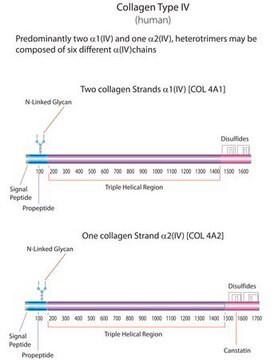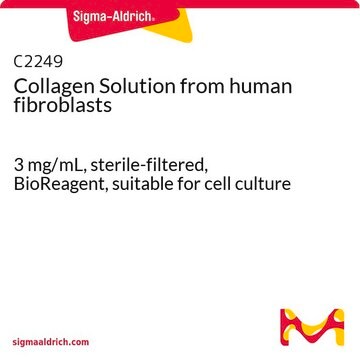C6745
Human Collagen Type IV
from human cell culture, liquid, 0.3 mg/mL, suitable for cell culture
About This Item
Produits recommandés
product name
Collagen Type IV from human cell culture, Bornstein and Traub Type IV, 0.3 mg/mL, sterile-filtered, BioReagent, suitable for cell culture
Source biologique
human cell culture
Niveau de qualité
Stérilité
sterile-filtered
Gamme de produits
BioReagent
Forme
solution
Poids mol.
170—180 kDa
Conditionnement
pkg of 1 mL
Concentration
0.3 mg/mL
Technique(s)
cell culture | mammalian: suitable
Couverture de surface
6‑10 μg/cm2
Impuretés
HBSAG, none detected
HCV, none detected
HIV-1/HIV-2, none detected
Numéro d'accès NCBI
Numéro d'accès UniProt
Spécificité de la liaison
Peptide Source: Laminin
Peptide Source: Nidogen
Conditions d'expédition
dry ice
Température de stockage
−20°C
Informations sur le gène
human ... COL4A1(1282)
Description générale
Collagen IV is a heterotrimeric molecules containing two α1-like and one α2-like chain. It is considered essential for completion of embryogenesis and is necessary for proper tissue organization and structural integrity. It is used in vitro as a substrate to enhance adherence and proliferation of many cell types. Produced by human fibroblasts and epithelial cells, Collagen IV is then purified biochemically and provided as a sterile solution at a concentration of 0.3mg/ml in 25% acetic acid.
Application
Actions biochimiques/physiologiques
Caractéristiques et avantages
- This Collagen Type IV product is generated by human fibroblasts and epithelial cells in a co-culture system, which produces an ECM in vitro.
- The Collagen Type IV is then purified biochemically.
- It is sterilized by dialysis in an acetic acid and 0.5% chloroform solution and is supplied sterile at a concentration of ~0.3 mg/ml in 25% acetic acid.
Code de la classe de stockage
11 - Combustible Solids
Classe de danger pour l'eau (WGK)
WGK 1
Point d'éclair (°F)
Not applicable
Point d'éclair (°C)
Not applicable
Équipement de protection individuelle
Eyeshields, Gloves, type N95 (US)
Certificats d'analyse (COA)
Recherchez un Certificats d'analyse (COA) en saisissant le numéro de lot du produit. Les numéros de lot figurent sur l'étiquette du produit après les mots "Lot" ou "Batch".
Déjà en possession de ce produit ?
Retrouvez la documentation relative aux produits que vous avez récemment achetés dans la Bibliothèque de documents.
Les clients ont également consulté
Articles
Extracellular matrix proteins such as laminin, collagen, and fibronectin can be used as cell attachment substrates in cell culture.
Extracellular matrix proteins such as laminin, collagen, and fibronectin can be used as cell attachment substrates in cell culture.
Extracellular matrix proteins such as laminin, collagen, and fibronectin can be used as cell attachment substrates in cell culture.
Extracellular matrix proteins such as laminin, collagen, and fibronectin can be used as cell attachment substrates in cell culture.
Notre équipe de scientifiques dispose d'une expérience dans tous les secteurs de la recherche, notamment en sciences de la vie, science des matériaux, synthèse chimique, chromatographie, analyse et dans de nombreux autres domaines..
Contacter notre Service technique









